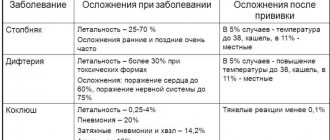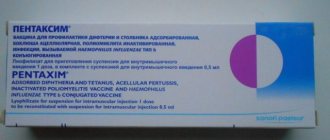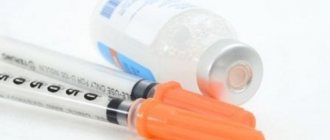Diphtheria is a dangerous infection, spread by airborne droplets, affecting the tonsils, pharynx, as well as the nervous and cardiovascular systems. To protect against diphtheria you need to get a vaccine. The peculiarity of preventing this infection is that the more people are vaccinated in a particular area, the less likely it is to spread the disease. According to sanitary rules, the percentage of vaccinated people should be 95% . There are several vaccines against diphtheria. AD-M and ADS-M are mainly used.
Diphtheria toxoid adsorbed with reduced antigen content (AD-M)
It is a monovalent vaccine, meaning it contains only diphtheria toxins . It is considered one of the safest vaccines. The vaccine contains five units of diphtheria antitoxin, iron hydroxide and a preservative.
Before vaccination, it is necessary to take a blood test for serological testing - to determine the amount of antibodies against diphtheria in the blood; if the result is within the normal range, then there is no need to be vaccinated.
Vaccination against diphtheria is mandatory and approved by the national calendar of the Russian Federation, therefore, if there is no desire to be vaccinated, adults have the right to write a refusal for themselves or their child.
Complication statistics
In medicine, post-vaccination reactions are considered pathologies that developed no later than 48-72 hours after the injection. Any cases with significant complications are investigated by a special commission and carefully recorded.
According to medical monitoring data, the following post-vaccination reactions were recorded:
- with high temperature (above 38.5) - 1%;
- with tissue swelling more than 5 cm in diameter and pronounced compaction more than 2 cm - in 4%;
- with allergic manifestations (rash, itching, burning) - in 2%.
Official science does not provide the number of people who became ill after vaccination with tetanus and diphtheria, but isolated such cases are described on the Internet and in medical journals.
Diphtheria toxoid adsorbed with a low amount of antigen (AD-M)
It was usually used after an increase in the incidence of diphtheria in a specific area as an emergency prophylaxis for persons who had not been vaccinated previously - for their protection. Considering that no cases of diphtheria have been registered in the Russian Federation for two years, the need for a vaccine is gradually disappearing.
If you do not have a tetanus vaccination, then there is no point in giving you only diphtheria toxoid, since each vaccination is compared to an operation, because this is a big burden on the immune system , and it is better to give several vaccines at a time in different places. ADS-M is also used in cases where a person has already developed immunity against tetanus and there is no point in getting vaccinated with ADS-M.
What does the ADS-M vaccination mean and how does it differ from the others?
Instructions for use of the ADS vaccine indicate that the vaccine protects against tetanus and diphtheria. The abbreviation stands for:
- A – adsorbed;
- D – diphtheria;
- C – tetanus.
If you compare it with ADS-M, the difference will be only one letter. M stands for reduced component volumes. If you compare it with the DTP vaccine, then there is K - pertussis bacteria.
The table clearly shows the difference between the ADS, ADS-M and DPT vaccines.
Table comparison of ADS, ADS-M and DTP vaccines
| Options | ADS | ADS-M | DTP |
| Immunity from diphtheria | Yes | Yes | Yes |
| Immunity from tetanus | Yes | Yes | Yes |
| Immunity from whooping cough | No | No | Yes |
| Reduced doses | No | Yes | No |
| When they do | From 3 months | From 6 years old | From 3 months |
Diphtheria-tetanus toxoid with reduced antigen content (ADS-M)
Contains attenuated diphtheria and tetanus toxins. Tetanus is a dangerous infectious disease transmitted through a contact mechanism and characterized by damage to the nervous system, in particular convulsions. Tetanus can be transmitted through any wounds (knife, bullet, cut, etc.), animal bites (dogs, rodents and pigs) and medical procedures using sterile instruments. The only effective means of prevention is vaccination.
ADS-M is a Russian drug created to maintain immunity after DTP . The vaccine contains ten units of diphtheria antitoxin, ten binding units of tetanus toxoid, ferric hydroxide and a preservative.
Indications for use:
- Children aged 6 and 16 years old. Before this, children are vaccinated with the DTP vaccine - pertussis-tetanus-diphtheria vaccine;
- Adults once every 10 years, that is, at 26, 36, 46, 56 years old and so on;
- Persons who do not have information about vaccinations against diphtheria and tetanus;
- Children under 6 years of age who have had whooping cough;
- Children who have contraindications to DPT;
- Emergency prevention of tetanus and diphtheria;
The drug can be administered together with other vaccines in accordance with the national schedule of preventive vaccinations.
Important! Emergency prophylaxis of tetanus must be carried out within 20 days after probable infection.
What's the difference between Adsm and Akds?
Problems related to the health and formation of artificial immunity in the baby worry and excite every responsible parent. It is necessary to create the best protection for the child from negative environmental factors of an infectious nature - then he will be able to grow up healthy and strong. The very first vaccination that a baby receives in the maternity hospital is the DPT vaccine.
Most of the parental questions are related to how the child’s body will react to the first vaccine in its life, but how to protect an older child from infections? For this purpose, children are vaccinated with ADSM.
ADSM vaccination is carried out against tetanus and diphtheria
ADSM: how does it stand for and what is the vaccine against?
ADSM can be deciphered as diphtheria-tetanus toxoid with a reduced content of the diphtheria component. With DPT, additional protection is also added against whooping cough.
Vaccination can be carried out from a very early age to protect children from the negative effects of diphtheria and tetanus.
After the first vaccination, many children feel unwell, which forces parents to refuse to go to the doctor again.
Diphtheria, whooping cough and tetanus are dangerous infectious diseases of a bacterial nature that have the ability to negatively affect the child’s body.
Paralysis of the nervous system, convulsions, pain in the limbs, aches, fever, nausea and vomiting, loss of consciousness, disorientation in space are only a small part of the symptoms of these infectious diseases.
It is better to complete the entire course of vaccinations once than to undergo long-term treatment for disabling consequences.
What is the difference between Adsm and Akds?
There is a significant difference between the two forms of almost identical vaccines: DPT contains 30 units of diphtheria and 10 units each of tetanus and pertussis toxoids, and ADSM contains 5 units of the first two biological components each.
Most often, DPT is given before 6-7 years of age, and after reaching this age (if there was a medical exemption or contraindications to vaccination), only DPT is given without an additional component.
This is due to the fact that children’s bodies react differently to the introduction of pathogenic substances in the form of antigens.
Treatment and measures used for therapy do not depend in any way on the choice of drug for vaccination. The history of infectious diseases also does not play a role. In this case, it is important to make a primary diagnosis, which is determined based on the picture of the disease. The medical record usually indicates the date of vaccination and its consequences. The information is then sequentially deciphered by the doctor.
Composition and instructions for use of the vaccine
The drug consists of a carefully adsorbed suspension of inactivated microbial bodies of whooping cough and purified tetanus and diphtheria toxoids. Various preservatives are used as a fixative, which do not harm human health.
Where is the vaccine given? According to the instructions, the injection is made only intramuscularly, where the child’s muscle layer is most pronounced:
- under the shoulder blade;
- in the shoulder area;
- in the thigh.
It is done only intramuscularly: in the thigh, shoulder or under the shoulder blade
The injection should only be given by a doctor or nurse at a clinic or medical center.
Such a strict rule was introduced in order to fully comply with the rules of asepsis and antisepsis: this will help to avoid purulent complications and prevent the development of infection at the injection site.
After the procedure, you need to carefully monitor the baby’s health for several days and consult a doctor at the first alarming symptoms.
Childhood vaccination schedule
The infant and child vaccine schedules depend only on the timing of the first DPT injection. If for some reason the baby cannot tolerate the vaccine with the pertussis component, then it is replaced with ADSM. The early childhood vaccination schedule is as follows:
- 3 months;
- 4.5 months;
- 6 months;
- 1 year and 6 months - revaccination No. 1 (r1).
If a standard DPT vaccination has already been performed in infancy, then the drug is administered to a child over 6 years of age without the pertussis component.
- r2 - at 6 years of age (less often - at the age of four) - revaccination No. 2;
- r3 - given 10 years later - at 16 years (or at 14, if the previous one was done at 4 years) - revaccination No. 3.
Adults need to be vaccinated every 10 years. Many parents are afraid to give an injection, since it is quite difficult for an unprepared child’s body to tolerate. After vaccination, it is recommended not to visit educational children's institutions for some time, not to contact infectious patients and not to get hypothermic on the street in the autumn and winter seasons.
Consequences of vaccinations in a child
DPT without the inclusion of the pertussis component is traditionally much easier to tolerate. It is believed that it causes most of the spontaneous allergic reactions caused by the body's hypersensitivity to the substance. It is necessary to get vaccinated under the shoulder blade or hip from an early age, since at an older age most children already have a serious chance of encountering an infection.
Normal reaction
The normal reaction of a child’s body to ADSM vaccination is:
- a slight increase in temperature to 37 degrees;
- lethargy, inactivity, refusal of active games;
- loss of appetite;
- drowsiness;
- nausea;
- impaired limb mobility;
- thickening of the skin in the injection area;
- swelling of the limb;
- lethargy.
Such a clinical picture is completely natural and should not cause any suspicion. Toxoids for diphtheria and whooping cough disease cross-react with antibodies and antigens, forming stable complexes that subsequently protect the human body. The immune system becomes more resistant to external irritants.
Possible complications
Some of them go away on their own without medical intervention. To remove others, you will have to work hard. ADSM vaccination is used often enough to evaluate possible side effects:
- serum sickness;
- disorders of the nervous system (meningitis, encephalitis, polyneuritis, encephalopathy);
- impaired sensitivity of the lower extremities;
- nausea and vomiting;
- dizziness and headache;
- temperature above thirty-eight degrees;
- joint pain, swelling, inflammation;
- keloid disease;
- secondary immunodeficiency;
- the occurrence of infection.
In some cases, after ADSM, nausea, vomiting, dizziness and more serious complications occur.
Contraindications to ADSM
In special cases, parents have to refuse ADSM vaccinations, since vaccination has a negative effect on the body.
After some time, after the ADSM vaccination is administered, some pathogenic reaction may occur, which is associated with the hyperreactivity of the body and the action of external factors.
The composition of the vaccine is aggressive, which is why it cannot be used for the following conditions:
- fever within two weeks before vaccination;
- hypersensitivity to ADSM components;
- low and very low birth weight (less than two kilograms);
- the presence of diseases of the cardiovascular, respiratory, genitourinary systems in the acute phase;
- hemolytic disease of newborns;
- intestinal infections, acute respiratory viral diseases or bacterial intoxications suffered within a month;
- progressive diseases of the nervous system;
- fetal growth retardation syndrome;
- acute hypoxia at birth;
- secondary or primary immunodeficiency;
- upcoming surgery;
- surgery less than two months old;
- active reaction to the previous administration of ADSM.
ADSM has its own contraindications, which must be discussed with your doctor before planning to get vaccinated.
This is a complete list of pathologies for which vaccination should be postponed until better times. The schedule of mandatory vaccinations according to ADSM can be adjusted with the help of a doctor.
You cannot vaccinate yourself without consulting a specialist: side effects can be unpredictable.
The composition of the vaccine is highly specific, which makes it not only a universal cure for tetanus and diphtheria, but also one of the most common allergens.
Similarities of vaccinations
The toxoid is obtained by adsorption in the laboratory from Corynobacterium diphtheria (the causative agent of diphtheria). The purpose of adsorption is the accumulation of bacterial toxins (liquid phase) on aluminum hydroxide (solid phase) by separating the two phases. Once collected, toxins are weakened by formaldehyde and exposure to high temperatures for safe vaccination.
Particles of the pathogen, even weakened ones, after entering the body trigger immunity. The body develops a response to a specific pathological agent and forms specific antibodies (protein compounds). When the pathogen subsequently enters the body, it is destroyed by antibodies produced in advance.
| Indications | Contraindications | Restrictions |
| Routine vaccination of children | High sensitivity to the components of the drug | Exacerbation of a chronic disease |
| Revaccination of adults | Tumors | Pregnancy |
| Persons vaccinated more than 10 years ago, as well as those who do not have information about vaccination against diphtheria | Severe reaction to a previous vaccine | Allergy |
| Emergency prevention of diphtheria | AIDS | Use of cytostatics |
Mode of application
They are vaccinated against diphtheria in a medical institution in a vaccination or treatment room. Vaccines should be stored in a separate refrigerator at a temperature of 4 to 8 degrees Celsius. The vaccine is administered intramuscularly (upper right quadrant of the buttock or upper thigh), as well as deep subcutaneously (under the shoulder blade). Before vaccination, the doctor should interview the patient about the presence of complications, severe reactions to vaccines in the past and conduct an examination to determine the general condition by measuring blood pressure and body temperature. Before the procedure, the doctor is obliged to inform about the need for vaccination and possible reactions of the body. After receiving the vaccine, you must stay in a medical organization for 30 minutes under the supervision of doctors.
Side effects and complications after administration of AD-M and ADS-M
There may be itching, swelling, swelling and redness at the injection site. Common reactions include weakness, fever, angioedema, and anaphylactic shock. After strong reactions to the vaccine, such people are stopped from scheduled specific prophylaxis.
Important! The likelihood of a severe allergic reaction is less than the possibility of infection and severe disease in the absence of vaccination!
Contraindications for immunization
Immunization of children is a voluntary procedure. Parents have the right to independently decide whether their child should be vaccinated or not. Therefore, the main contraindication for the administration of serum is the desire of the parents. In this case, the child’s legal representative signs a waiver of vaccination indicating its validity period. If necessary, it will be possible to vaccinate later.
Health contraindications:
- acute respiratory viral infections;
- period of exacerbation of chronic diseases;
- disruption of the central nervous system;
- severe injuries received during childbirth;
- postoperative period;
- rehabilitation after serious illnesses;
- decreased protective functions of the body;
- elevated body temperature of unknown origin;
- taking certain medications (immunosuppressants, corticosteroids, hormones);
- blood diseases;
- tumors.
Results
Tetanus and diphtheria pose a great threat to the body , and in order to protect it and protect yourself from severe complications and the likelihood of death, you need to think about specific prevention - once every 10 years . The use of ADS-M is becoming a thing of the past due to the lack of registration of cases of diphtheria and the need to vaccinate people at risk of diphtheria, since there is a combination vaccine ADS-M.
Medicine and healthComment
Action Comparison
The DTP vaccine is intended to build immunity against three infections - tetanus, whooping cough and diphtheria, and is most often used in young children. Protection after primary vaccination does not last a lifetime, so it needs to be renewed periodically. One vaccination dose contains 30 units. diphtheria antigens, 60 units. tetanus toxoid and at least 4 units. pertussis component plus the preservative merthiolate.
What do you think are the most important factors when choosing a medical facility?
The ADS-M vaccine contains a smaller volume of toxoids (therefore it is considered weakened), it also does not contain a pertussis component and is used mainly in older children and adults to enhance anti-tetanus and anti-diphtheria protection after DPT vaccination. One dose of diphtheria and tetanus vaccine ADS-M includes 5 units. antigens - tetanus and diphtheria toxoids, preservative thiomersal and excipients.
What vaccines are there in Ukraine?
Below are vaccines containing diphtheria toxoid, indicating the country of production and components. By clicking on some vaccines, you can see detailed information, including their availability in some health centers.
Age indications and restrictions
DPT, AAKDS, ADS - from 2 months until the age of 7 years.
ADS (not ADS-m) is usually used for revaccination of children at 6 years of age according to the vaccination schedule.
If the administration of DTP with whole cell pertussis is contraindicated (for example, in the presence of epilepsy), ADS or AADT can be administered. The latter, as already mentioned, contains an acellular form of the pertussis component. By the way, this is the only point of intersection of vaccination for neurological conditions.
ADS-m - from 7 years and adults.
AAKDS-m - from 4 years and adults.
This may all seem complicated. The vaccine card service, Vakarta, which I develop in my free time, will help you create individual vaccination schedules for all family members.
DTP drugs
The DTP vaccine itself contains three components (whooping cough, diphtheria, tetanus):
- DTP (India) - in public clinics
- Infanrix (Belgium)
DPT+IPV
Quadruple vaccines additionally contain an IPV (inactivated polio vaccine) component. Both of these vaccines are equivalent and interchangeable:
- Tetraxim (France)
- Infanrix IPV (Belgium)
DPT+IPV+Hib
Five-component vaccines additionally contain a Hib (Haemophilus influenzae type b) component. Two immunologically identical vaccines:
- Pentaxim (France)
- Infanrix IPV Hib (Belgium)
DPT+IPV+Hib+HepB
Six-component vaccines also have a component against hepatitis B. There are also two identical hexa vaccines:
- Hexaxim (France)
- Infanrix Hexa (Belgium)
Belgium and France - which is better?
The above pairs of French and Belgian vaccines are completely identical, interchangeable, provide the same protective effect and have the same minor side effects. Both are equally good. Let me remind you once again that the country of production does not matter. It is important that the vaccine contains the ingredients that you or your child need.
BP-m
Monovaccine against diphtheria. If there are no other vaccines, but there is one, then it may be an option. But, of course, it will not provide protection against tetanus. Used in age groups similar to ADS-m.
ADS-m
The most common vaccine for adults. Can be used from 7 years old. There are Ukrainian, Indian, Bulgarian production (no difference). Available in public clinics, also available in private medical centers.
DTP-m
More precisely, AaKDS-m. Vaccine for adults and children over 4 years of age. Typically used for revaccination (booster vaccination).
In Ukraine it is represented by two vaccines - DTaP-m itself, and also in combination with IPV:
- Boostrix (Belgium)
- Boostrix Polio (Belgium)
Preparation, injection site
In order for everything to go well, pediatricians ask parents to follow the instructions a few days before administering the ADSM vaccine:
- try to ensure that the child has less contact with other people;
- do not introduce new products to the menu (it is unknown how the body will react to them);
- do not bathe three days before the procedure;
- give children antiallergic drugs (two days before and after the injection).
Some parents may object: why such precautions, what bad could happen if you drop in to visit friends for a couple of hours?
Doctors are sure that little things cannot be neglected - what if the baby catches some kind of virus, the same cold?
He will have to spend a “piece” of immunity to fight these unforeseen obstacles, and the body’s protective functions will be weakened at the time when they must withstand a more serious test.
Where do children get the ADSM (ADS-M) vaccine? How painful and effective is it?
The ADSM vaccine is administered intramuscularly - this way the drug enters the blood at the speed necessary for the success of the procedure.
The option of injection into the subcutaneous tissue is not suitable: the vaccine will appear in the blood too slowly and will not give the effect for which it is designed (there have been cases when in such situations vaccination was found to be ineffective and had to be redone), in addition, a painful lesion forms at the injection site cone.
The drug is injected intramuscularly into the thigh, under the shoulder blade or into the shoulder.
The choice of "target" for the syringe depends on how large the patient's muscle mass is. For younger children whose muscles are not well developed, the thigh area is best suited.
What about the injection in the buttock, parents ask? Usually this is where doctors aim the syringe (remember the famous episode from the film “Prisoner of the Caucasus”).
It turns out that injecting ADSM into the buttock is strictly prohibited due to the risk of injury to the sciatic nerve, as well as the likelihood of the drug entering not into the muscle (it is located relatively deep), but under the skin.
To avoid or minimize the side effects of ADSM vaccination in a child, we give a few more recommendations:
- The body will tolerate vaccination more easily if the intestines and stomach are empty;
- after the procedure you need to drink more water, but eat less;
- Stay for half an hour or forty minutes at the clinic after completing your appointments so that in case of an allergic reaction, your child can receive immediate help.
People often ask: are antibiotics used for tracheitis in children? Find out about it right now!
Instructions for using Pantogam tablets for children are discussed in detail in our article.
Vaccine reaction and side effects
The most alarming are the first three days, during which the temperature can rise to 37 (and then nothing needs to be done) or up to 39 degrees (in this case, antipyretics are needed).
A rise in temperature after ADS-M vaccination means that the immune system is functioning as it should.
The injection site itself may bother and hurt; sometimes after the ADSM vaccination there is redness, thickening and swelling.
The painful condition is sometimes accompanied by the following reactions:
- vomit;
- loose stools;
- poor appetite;
- slowness of reactions;
- whims.
All these troubles quickly pass without any medical or parental intervention.
Heating pads and warming compresses are strictly contraindicated, as they can cause suppuration!
If the baby experiences severe pain or the mobility of the limbs is impaired, you should seek help from a doctor.
Advantages
- Bivalent vaccination preparations are more easily tolerated by the body than monovalent (single-component) ones, due to the fact that in order to successfully combine the two biological components they are very carefully purified and they are “mild” in their effect on the body.
- Ballast substances enter the blood once, i.e. in a reduced dose.
- One injection is given, not two.
- Stable immunity to vaccinated infections lasts for at least 5 years.
The effectiveness of ADS and ADS-M vaccinations is confirmed by statistical data; it reaches 80-100%. For example, vaccination, which began in America in the 40s, led to a decrease in infection from 0.4 cases per 100 thousand population to 0.02 per 100 thousand population in the 90s.
Infections prevented by ADS and ADS-M have in the past claimed thousands of lives during epidemics and without effective treatments or led to disability among those infected. Despite the fact that their incidence has now sharply decreased, these bacteria have not disappeared from the biosphere. It was the creation of vaccines that made it possible to curb the increase in the incidence of these dangerous diseases and became the main method of combating them.
Romanovskaya Tatyana Vladimirovna
Instead of a final word
There was an outbreak of diphtheria in Alaska in 1925. The storm blocked the delivery of life-saving antitoxin to the city of Nome. It could only be delivered by dog sled. And when the accompanying person suffered a leg injury halfway through the journey, the dog Balto, who remembered the road, led the team to the city himself. Thus, he saved many lives.
Monument to Balto in New York's Central Park
Watch the cartoon "Balto", even if you have already seen it. Watch it with your whole family.
Get vaccinated against diphtheria yourself, vaccinate your children, and persuade your loved ones to do it.
Create an individual vaccination card at vakarta.com
Consult and get vaccinated from doctors who adequately understand this issue.
Share
Stepan Beglaryan
, pediatrician, pediatric immunologist.
I provide consultations at the reception (Kyiv), as well as online.
I am developing an online immunological test and a vaccine card - Vakarta.
Contact details - please contact us.
Check your child's immune system: online immunological test
Draw up a personal vaccination schedule: vakarta - vaccine card
For adult patients: Ilona Beglaryan – therapist, cardiologist
How to help your child after the procedure
Pay more attention to your baby than usual, because he really feels bad after the ADSM vaccination - fever, weakness, pain in the place where the injection was given.
Sometimes it is enough to distract the baby with an interesting book, sometimes it is impossible to do without some procedures that alleviate his condition.
You can apply ice to the sore spot, give a painkiller (check with your pediatrician about which one), use ointments that increase blood flow and quickly return the inflamed area of skin to its normal state.
One of the most frequently asked questions to doctors is: “Is it possible or not to wet the place where the ADSM vaccine was given?” Doctors say: “It’s possible.”
However, serious water procedures (washing in the bathroom, swimming pool, swimming in the river) should be postponed for a while.
Dr. Komarovsky will tell you which actions after vaccination are desirable and which are not:










